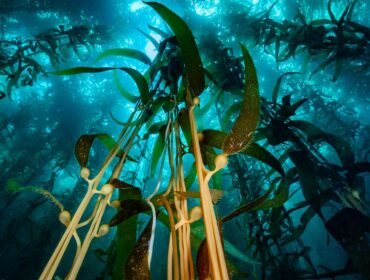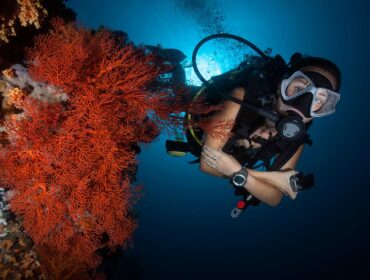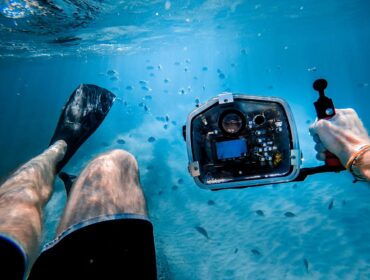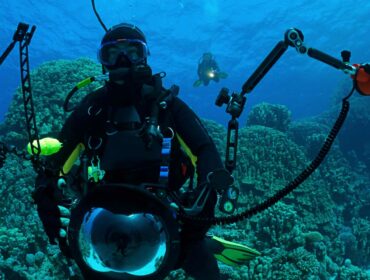If you’re just starting out in the world of underwater photography, it can be a little overwhelming. You need to know your camera well enough to learn how to use its functions through a housing before you ever take it in the water. Once you’ve got that down, follow these underwater photography tips to get the best shots you can get in your first few dives.
Use a strobe
Though not always necessary, strobes can make a huge impact on your underwater photographs. A strobe helps introduce light more light to the scene, which helps bring out the true colors of your subject and reducing the green and blue wavelengths that dominate most underwater images. A strobe also helps freeze motion and elicit higher shutter speeds from your camera, which is critical when shooting skittish or highly active marine life.
Shutter speed
Setting camera shutter speed is always a tricky issue in underwater photography. If you set the shutter to a lower speed, you’ll get more light, but your subjects will be blurry. A higher shutter speed will freeze motion and capture detail, but not enough light, leading to a dark background that some photographers find undesirable. The trick is to use a high ISO setting, a powerful strobe and a medium shutter speed that will capture enough ambient light without blurring the subject.
Stay in shallower water
For the best underwater photographs while starting out, stay in shallower waters where the light from the sun penetrates the entire water column. The shallower you are, the less light is absorbed by the water, leaving you with vibrant, true colors to work with. If you do not have a strobe, shallow waters are the best place to start practicing composition and using your camera’s settings to get the best results. Then you’ll be ready to shoot in deeper waters when you have a strobe to mimic the effect.
Get close to your subject
Perhaps one of the more common tips for new underwater photographers is to get close as close to your subject as your camera lens — and the subject — will allow. Water is 800 times denser than air, and the further you are from the subject, the more blue and green wavelengths will be recorded. Even if you are using a strobe, getting closer to your subject will enable you to capture sharp details details, distribute the most light, and reduce the occurrence of backscatter.
Use a color correcting filter
A very well known tip to get better looking underwater images is to use color correction filters on your camera, which are essentially red filters that are screwed onto the front of your camera’s lens. It corrects the color balance by reducing the cyan in your pictures, and can also be useful in reducing backscatter. It is important to remember to increase your camera’s exposure by 1 to 1.5 stops to compensate for the filter’s density. The filter is of no use at depths below 30 feet, as red, orange, and yellow wavelengths all disappear.
Shoot when the sun is overhead
Shoot while the sun is directly overhead for the best natural lighting in your underwater photos. Light refracts off the surface of the water when the sun’s light is angled, and only a part of the light enters the water. When overhead, the sun’s beam on the water is the widest. It is still beneficial to use a strobe if you are below 30 feet.
Master buoyancy control
One of the biggest tips we can give to anyone wanting to take up underwater photography is to master buoyancy control first. The secret to all sharp photographs is steady hands and no camera shake. The only way to achieve this underwater is to be absolutely stationery and hover using breathing techniques. Using coral or underwater objects to stabilize yourself is unacceptable, as is standing, kneeling, or laying on the seafloor. Master your buoyancy control, and you’ll be amazed how much easier it makes to focus on your shot.
Minimize backscatter
One of the most aggravating things underwater photographers deal with in their images is backscatter. Backscatter is the reflection of suspended particles that render on the image as a bright white (sometimes colored) spot. This effect can be minimized by using a strobe arm and aiming the top down so that the particles will not be illuminated in front of the lens. You can also opt for a patterned background or getting even closer to your subject.
Use post processing to correct flaws
Using a good image editing software, you can add filters, correct color, and eliminate little flaws or spots that will really improve the quality of your final image. While a post processing software can drastically enhance any of your underwater photographs, and can even be used for artistic liberties, focus your time and energy first on carefully composing your images and learning the right settings. You’ll spend far less time in front of the computer and more time doing what you love!
Images via papertygre, Photograph Curator







